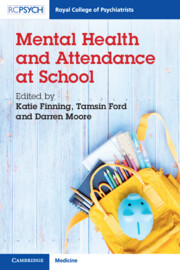Book contents
- Mental Health and Attendance at School
- Mental Health and Attendance at School
- Copyright page
- Contents
- Contributors
- Preface
- Acknowledgements
- Chapter 1 Mental Health and Attendance at School
- Chapter 2 School Attendance
- Chapter 3 Emotional Disorders and Attendance at School
- Chapter 4 Behavioural Disorders and Coping with School
- Chapter 5 Neurodevelopmental Disorders and Attendance at School
- Chapter 6 Educating a ‘New Me’ after an Acquired Brain Injury
- Chapter 7 School Influences on Attendance and Special Educational Needs
- Chapter 8 Supporting the Attendance of Vulnerable Children at School
- Chapter 9 School Attendance and Anxiety
- Chapter 10 Reflections on the Impact of Covid-19 on Children’s Education and Mental Health
- Index
- References
Chapter 5 - Neurodevelopmental Disorders and Attendance at School
Published online by Cambridge University Press: 24 March 2022
- Mental Health and Attendance at School
- Mental Health and Attendance at School
- Copyright page
- Contents
- Contributors
- Preface
- Acknowledgements
- Chapter 1 Mental Health and Attendance at School
- Chapter 2 School Attendance
- Chapter 3 Emotional Disorders and Attendance at School
- Chapter 4 Behavioural Disorders and Coping with School
- Chapter 5 Neurodevelopmental Disorders and Attendance at School
- Chapter 6 Educating a ‘New Me’ after an Acquired Brain Injury
- Chapter 7 School Influences on Attendance and Special Educational Needs
- Chapter 8 Supporting the Attendance of Vulnerable Children at School
- Chapter 9 School Attendance and Anxiety
- Chapter 10 Reflections on the Impact of Covid-19 on Children’s Education and Mental Health
- Index
- References
Summary
In this chapter I outline the features of common neurodevelopmental disorders (NDD), the link between NDD and special educational needs and disability, and types of school attendance problems that occur for young people with NDD. I discuss common contributing factors to problems with school attendance for young people with NDD at the individual and school levels. Suggestions for promoting attendance and understanding attendance problems for young people with NDD are discussed throughout. Young people with NDD are at higher risk than their peers of having many of the risk factors for poor school attendance: low academic achievement, sensory difficulties, physical health problems, poor social or academic skills, co-occurring conditions, difficulty verbally communicating anxiety or frustration, being bullied, having difficulties with relationships, and low self-esteem. School absences in these young people may be due to a multitude of reasons, embedded in complex social conditions including family and school factors. Adaptations to the school environment and individually focussed cognitive and behavioural approaches adapted to the needs of young people with NDD are most likely to help in addressing problems with school attendance. Effective management, support and treatment of symptoms due to NDD is likely to improve the school attendance of these young people.
Keywords
- Type
- Chapter
- Information
- Mental Health and Attendance at School , pp. 78 - 105Publisher: Cambridge University PressPrint publication year: 2022
References
- 1
- Cited by



